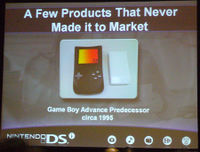| Site Notice |
|---|
|
We have a limited coverage policy. Please check our coverage page to see which articles are allowed. |
Difference between revisions of "Game Boy Advance predecessor"
m |
m |
||
| Line 2: | Line 2: | ||
The "'''Game Boy Advance predecessor'''" was a handheld game console intended to be the successor to the [[Game Boy]]. According to [[Masato Kuwahara]], the system was in development around 1995, and was intended to launch before the {{wp|1996 Summer Olympics}}.<ref name="GDC 2009">[http://www.gamasutra.com/view/news/113860/GDC_Nintendo_Reveals_1000_Point_DSiWare_Promotion_New_Game_for_the_US_DSi_Secrets.php GDC: Nintendo Reveals 1,000 Point DSiWare Promotion, New Game for the U.S., DSi Secrets]. Gamasutra (March 25, 2009). Retrieved January 6, 2017.</ref> | The "'''Game Boy Advance predecessor'''" was a handheld game console intended to be the successor to the [[Game Boy]]. According to [[Masato Kuwahara]], the system was in development around 1995, and was intended to launch before the {{wp|1996 Summer Olympics}}.<ref name="GDC 2009">[http://www.gamasutra.com/view/news/113860/GDC_Nintendo_Reveals_1000_Point_DSiWare_Promotion_New_Game_for_the_US_DSi_Secrets.php GDC: Nintendo Reveals 1,000 Point DSiWare Promotion, New Game for the U.S., DSi Secrets]. Gamasutra (March 25, 2009). Retrieved January 6, 2017.</ref> | ||
| − | + | As with the other Game Boy iterations, the device had a similar form factor and button layout to the original Game Boy, though it was much larger than the other systems. It also had two additional face buttons, similar to the layout of a [[Super Nintendo Entertainment System Controller|SNES Controller]]. The hardware would have featured a color {{wp|Liquid-crystal display|LCD}} screen, and used a 32-bit {{wp|ARM7}} CPU.<ref name="GDC 2009"/> The system was ultimately cancelled due to its impractical size and performance issues related to the inefficient ARM7 graphics engine.<ref name="GDC 2009"/> | |
{{-}} | {{-}} | ||
Latest revision as of 23:54, 14 February 2018
The "Game Boy Advance predecessor" was a handheld game console intended to be the successor to the Game Boy. According to Masato Kuwahara, the system was in development around 1995, and was intended to launch before the 1996 Summer Olympics.[1]
As with the other Game Boy iterations, the device had a similar form factor and button layout to the original Game Boy, though it was much larger than the other systems. It also had two additional face buttons, similar to the layout of a SNES Controller. The hardware would have featured a color LCD screen, and used a 32-bit ARM7 CPU.[1] The system was ultimately cancelled due to its impractical size and performance issues related to the inefficient ARM7 graphics engine.[1]
References
- ↑ 1.0 1.1 1.2 GDC: Nintendo Reveals 1,000 Point DSiWare Promotion, New Game for the U.S., DSi Secrets. Gamasutra (March 25, 2009). Retrieved January 6, 2017.
| |||||||||||||||||||||
| |||||||||||||||||||||
| |||||||||||||||||||||


